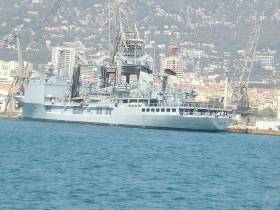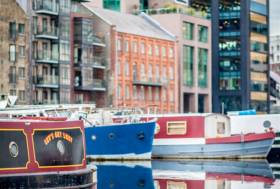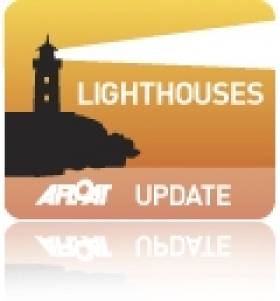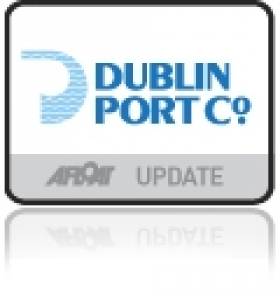Displaying items by tag: Open House Dublin
Flotilla From French Navy All to Arrive to Dublin Port This Friday
#FrenchFriday- A flotilla from the French Navy are all scheduled to have arrived to Dublin Port this Friday and in the capital the French embassy will on Saturday take part in 'Open House Dublin' this weekend, writes Jehan Ashmore.
Originally a quartet of French naval vessels were expected to call, however Afloat has monitored that this total has been reduced to three ships that are to visit. They are a minehunter, a frigate and an auxiliary oil/stores replenishment ship.
First to arrive at lunch hour today, will be the minehunter Sagittaire of the 'Eridan' class also otherwise known as the 'Tripartite' class. They are from a shared ship build programme that was co-ordinated with the combined co-operation of the French, Belgium and Dutch navies.
The 51m Sagittaire with a displacement of 615 tonnes is to arrive upriver along Sir John Rogersons Quay. This 21 year old vessel was completed by Direction des Constructions Navales (DCN) in Lorient, south Brittany.
The remaining pair are to arrive tomorrow, firstly in the form of the frigate Lieutenant de vaisseau Lavallée. This 80m vessel which is a 'Estienne d'Orves' class OPV frigate that among its principle weaponary consists of Exocet missiles. Likewise of the minehunter, the frigate will take a berth upriver on the Liffey along Sir John Rogersons Quay.
This leaves the final caller the 157m BCR Somme, the second of three 'Durance' class oil /stores supply sisters in which this particular ship entered service in 1990. The 18,000 full displacment tonnes ship is to dock within the deeper waters of Alexandra Basin. This is the largest basin within the port that is located close to the Tom Clarke bridge.
As previously reported here on Afloat, it is at the Tom Clarke bridge (seaward side) where the excursion boat St. Bridget will be operating (pre-booked) port tours (Saturday, 14 Oct) also as part of events during Open House Dublin. The tour is to take in Alexandra Basin where phase one of major redevelopment works has begun as part of the port masterplan.
Free Tours of Grand Canal Dock Houseboats During Open House Dublin Next Month
#InlandWaters - Houseboat tours in Grand Canal Dock will feature of Open House Dublin 2017 from 13 to 15 October.
The Irish Architecture Foundation has teamed up with Waterways Ireland to offer tours of four such houseboats stationed in the capital’s South Docklands to see if life on the water could be for you.
Homes on show include The Adriana, a Dutch barge built in 1898 as a working boat and converted into a live-aboard leisure craft in the 1980s.
The Barge Rambl'n Home Houseboat is a Collingwood wide-beam barge built to live on, while The Stil Mor Houseboat is a wide-beam narrow boat barge, and The Endeavour is a sensitively restored narrow canal barge.
Waterways Ireland will also be offering tours of ‘The Box in the Docks’, its building over the water at Grand Canal Dock and accessed by a footbridge from the quay wall.
Built in 1993, it was designed to represent a nautical theme, reflected in the round windows, the open aspect of the guardrails and the wooden decking of the walkway.
The floor-level windows give the impression that the building is moving through water or that you are even on a boat. The rooftop also offers one of the finest views of the Docklands.
Tours over the weekend of Open House Dublin will be on a first come, first served basis: simply turn up and look out for Open House Dublin volunteers. Given the space and weight restrictions of the house boats, small groups of two to three people will be allowed into each house boat for five minutes at a time.
Open House Dublin Takes to the Water With Boat Tours of Capital's Port
#dublinport - Beginning a month from today is Open House Dublin 2017, the annual event this year takes place on the weekend of (13-15 October).
As part of the weekend of venues and events organised by the Irish Architecture Foundation (IAF) is a boat tour of Dublin Port on the Saturday, 14 October.
The boat tour on board St. Bridget will focus on the unique opportunity to view the recent and ongoing works of the Alexandra Basin Redevelopment Project (ABR) as part of Dublin Port Masterplan 2012–2040.
The majority of Open House Dublin buildings are open access, but limited places in the case of this boat tour must be pre-booked in advance. To register a place, click the Eventbrite website here. Note of the three tours, at time of writing only two remained with spaces available.
Embarkation to board St. Bridget is located at the Ferry Quay Berth 18 (beside Thomas Clarke Bridge) otherwise widely known as the East-Link toll bridge. Please wear appropriate footwear and dress for the weather.
Open House Dublin is presented by the IAF which is a non-profit arts organisation that communicates the value of architecture.
The annual event is one part of the IAF's activities as they also have a year-round programme. This includes exhibitions, talks, film screenings, symposia, competitions, publications, school and community workshops.
#PortCentreTours – Open House Dublin is to feature the Port Centre, the headquarters of Dublin Port Company next weekend with public tours on Saturday 18 October (11.00am – 5.00pm) and Sunday 19 October (12.00pm – 5.00pm).
The Port Centre designed by Architects Niall Scott, Scott Tallon Walker is among over 100 tours, events and workshops during Open House Dublin (incl. Friday 17 October) organised by the Irish Architecture Foundation.
All events are free and most available on a first-come basis as will be the case of the Port Centre. The building was commissioned by DPC's predecessor, the Dublin Port and Docks Board (DP&DB) which intended the building with a strong visual presence in the port.
The six-storey building dating from 1981 sits on a raised podium with the top floor dedicated to plant and ancillary accommodation, while four floors provide office space with spectacular views over the city.
At the time of construction the Board undertook extensive consultation on modern office configurations and the building was designed to embrace change and innovation. The structure is expressed externally in pre-cast concrete columns and beams.
Last tour of the Port Centre is 30 minutes prior to closing. Tours based on a first-come basis, so just turn up and look out for Open House Dublin volunteers.
Location: Alexandra Road East Wall, (approximately mid-way) between the East-Link Bridge and Port Tunnel.
Public Transport: Dublin Bus Routes: 53/151 to East Wall Road or take the LUAS (Red Line) to The Point (terminus) noting city centre stops at Connolly Station and Busaras.
As previously reported, tours of the Commissioners of Irish Lights Headquarters in Dun Laoghaire Harbour are on Sunday 19 October.
Open House Dublin: Tours of Irish Lights Headquarters
#IrishLightsHQ - The striking designed headquarters of the Commissioners of Irish Lights is one of numerous places of interest to visit in this year's Open House Dublin.
The iconic landmark building that integrates seamlessly into its marine environment along the waterfront within Dún Laoghaire Harbour is open on Sunday 19 October, 12.00pm – 5.00pm
In 2008 Scott Tallon Walker Architects completed the building which comprises two main structures - a circular open-plan office building, linked via an elegant glass enclosed bridge, to a rectilinear engineering maintenance facility. The building utilises many innovative technologies to ensure sustainable building design and energy efficiency.
Visitor Information: First-come basis, just turn up and look out for Open House Dublin volunteers. Last entry: 30 minutes prior to closing. Closest Dart/Rail: Dún Laoghaire.
Visit the Open House Dublin website HERE, which is presented by the Irish Architecture Foundation. From 17 to 19 October over 100 tours, events and workshops will invite you to explore the rich architecture of Dublin. Events are completely free, with most available on a first-come basis.
Dublin Port HQ is an 'Open House' in the Capital
#DublinPortCENTRE – Open House Dublin (4-6 October) is to feature the Port Centre, the headquarters of Dublin Port Company which is among 100 buildings celebrating opening its doors to the public next weekend.
The Port Centre designed by Architects Niall Scott, Scott Tallon Walker will be open on both Saturday 5 (10am-5pm) and Sunday 6 (12noon-5pm).
The building was actually commissioned for the predecessor of Dublin Port Company, the Dublin Port and Docks Board (DP&DB) which intended the building with a strong visual presence in the port.
The six-storey building dating from 1981 sits on a raised podium with the top floor dedicated to plant and ancillary accommodation, while four floors provide office space with spectacular views over the city.
At the time of construction the Board undertook extensive consultation on modern office configurations and the building was designed to embrace change and innovation. The structure is expressed externally in pre-cast concrete columns and beams.
Last tour of the Port Centre is 30 minutes prior to closing. Tours based on a first-come basis, so just turn up and look out for Open House Dublin volunteers.
Location: Alexandra Road East Wall, (approximately mid-way between the East-Link Bridge and Port Tunnel).
Public Transport: Dublin Bus Route(s): 53/151 to East Wall Road or take the LUAS (Red Line) to the Point from city centre location stops at Connolly Station and Busaras.
As previously reported last week, the headquarters of the Commissioners of Irish Lights (CIL) in Dun Laoghaire Harbour is also open to viewing next weekend.
Irish Lights HQ To Welcome The Public For 'Open House Dublin'
#IrishLights - The headquarters of the Commissioners of Irish Lights in Dun Laoghaire is one of the 100 great buildings that will open to the public on the weekend of 4-6 October for Open House Dublin, the annual celebration of the city's architecture and history.
It seems fitting that the head office of the body that administers some of Ireland's most treasured coastal landmarks is itself an architectural wonder, a stunning rotunda of tinted glass ad steel designed by Scott Tallon Walker Architechts that's complemented the Dun Laoghaire waterfront since 2008.
Tours of the building will be on a first come, first served basis: just turn up and look out for Open House Dublin volunteers. See the Open House Dublin website for more.
Ports & Shipping Review: EU Ports Conference, Irish Cargoship Strikes Rock, Cruise Sector, Lifeline for WWI Warship, Lightship Scrapped and more…
#PORTS & SHIPPING REVIEW - Over the last fortnight Jehan Ashmore has reported from the shipping scene, where the European Commission hosted a major ports conference on the EU policy framework for ports.
Irish Ferries won 'Best Ferry Operator' in an award held in Birmingham, which was presented by Group Leisure, a leading British travel trade publication.
A brand new Irish flagged cargoship, Huelin Dispatch (2012/2,545grt) struck a rock while on its maiden voyage from Southampton to the Channel Islands. No crew were injured and the vessel was re-floated and then proceeded to dry-dock in Falmouth.
Large cruiseship operators could be a source of funding for the proposed redevelopment of Galway Port, a Joint Oireachtas Committee on Transport and Communications has been told.
Next year cruise passengers will be able for the first time to travel directly from Ireland to Norway on a major cruiseship from Cobh operated by Royal Caribbean International.
The 98 year-old HMS Caroline, berthed in Belfast, is to be given a lifeline, after the Stormont Assembly is to allocate £100,000 for restoration work on the famous World War I warship.
An industrial dispute over crew salaries and conditions at Brittany Ferries which ran for ten days ended earlier this week and where sailings on the Cork-Roscoff route returned to service yesterday.
The former headquarters of the Commissioners for Irish Lights in Dublin 2 is for sale at €2.85 million on the instructions of Nama, which is 89% drop on the €26 m paid for the block in 2006 by Pembroke Partnership.
A report by the MCIB was published into the grounding of Arklow Raider (2007/2,999grt) at the mouth of the River Boyne in 2010, nobody was injured and no pollution occurred.
One of the last surviving Irish lightships, ALF Skua which was automated in the early 1980's, finally ended her days as work on scrapping took place on the banks of the River Avoca in Arklow.
Today marks the final day of the Open House Dublin weekend, which was organised is to make architecture more accessible to the public and free of charge. Among the events today are guided tours (first come, first served basis) of the current headquarters of the Commissioners of Irish Lights and the National Maritime Museum of Ireland also located in Dun Laoghaire. For details visit www.openhousedublin.com
Open House Dublin takes to the Water
#OPEN HOUSE – Starting today is Open House Dublin weekend (5-7 October), which is an exploration of the vitality of Dublin through its architecture for people and to experience free of charge. A host of buildings otherwise normally closed to the general public are available to visit including maritime related tours.
An architectural tour of Dublin's Docklands quarter on board a Liffey sightseeing boat is to be presented by Minister for Education Ruairi Quinn T.D. Also taking transport while on a tour of buildings along Dun Laoghaire will be a yacht excursion along the south Dublin Bay coastline.
The Commissioners of Irish Lights, whose striking landmark headquarters in Dun Laoghaire Harbour, will be open to public tours. Further along the waterfront, close to the harbour's East Pier, is the National Maritime Museum of Ireland (NMMI) which is also to welcome visitors noting the opening hours on Sunday are between 11am to 5pm.
Please note that availability to these events which represent a handful in an extensive programme are subject to various viewing arrangements, as some had to be pre-booked, while others are based on a first-come first-served basis. For further details consult www.openhousedublin.com
Former Irish Lights Headquarters for Sale
#PROPERTY HQ– The Irish Times reports that the Dublin based former headquarters of the Commissioners for Irish Lights are to be offered for sale at €2.85 million on the instructions of Nama – a 89 per cent per cent drop on the €26 million paid for the block in 2006 by Pembroke Partnership.
Wesley Rothwell of CBRE says the building, (located on 16-19 Pembroke Street in Dublin 2), has not been occupied since it was sold, is now in need of extensive refurbishment.
The property became redundant when the Commissioners relocated in 2008 to a brand new custom-built HQ on the waterfront within Dun Laoghaire Harbour. As previously reported on Afloat.ie, the distinctive landmark building is to be open to the public next Sunday as part of the Open House Dublin Weekend.






































































